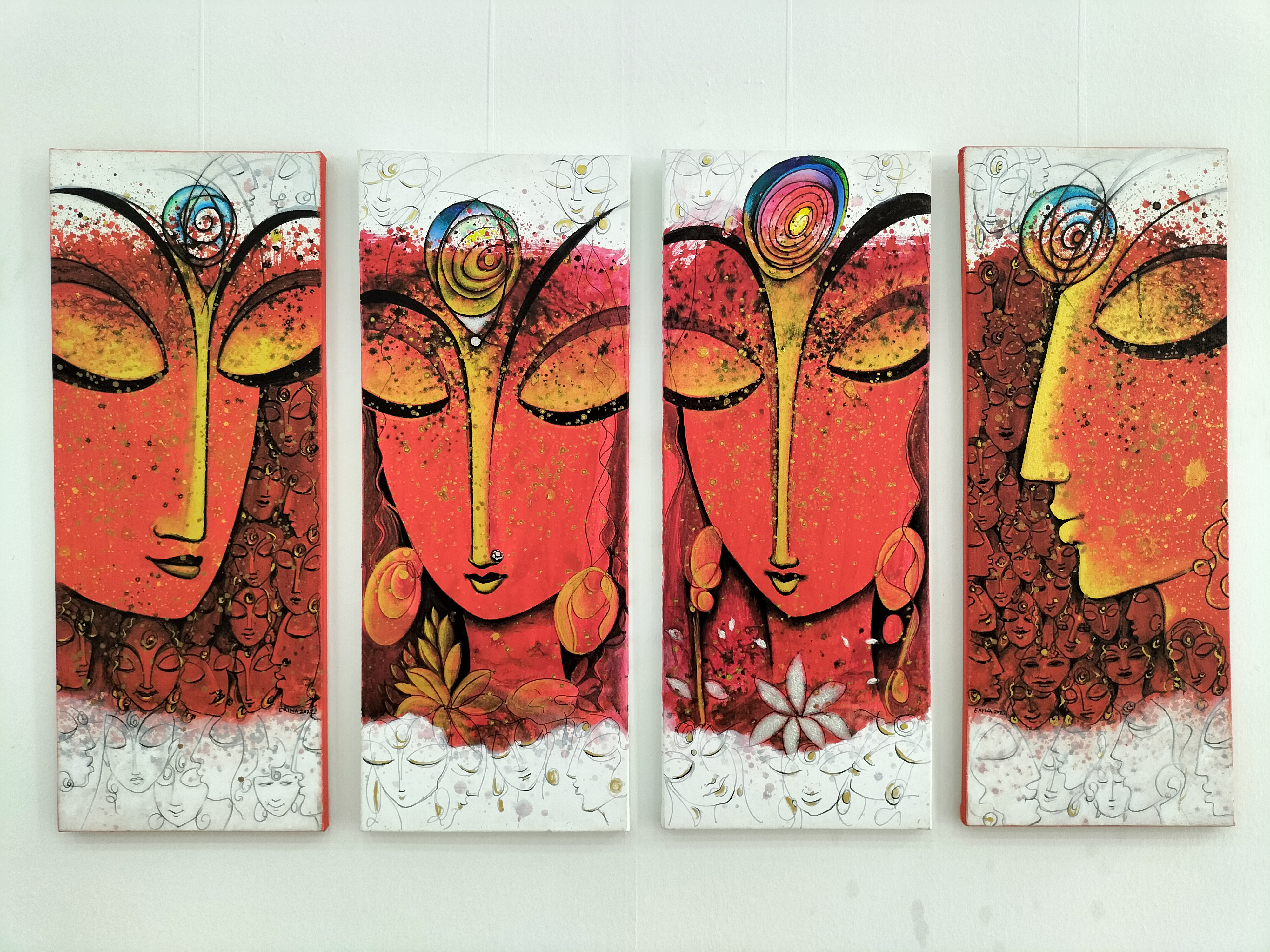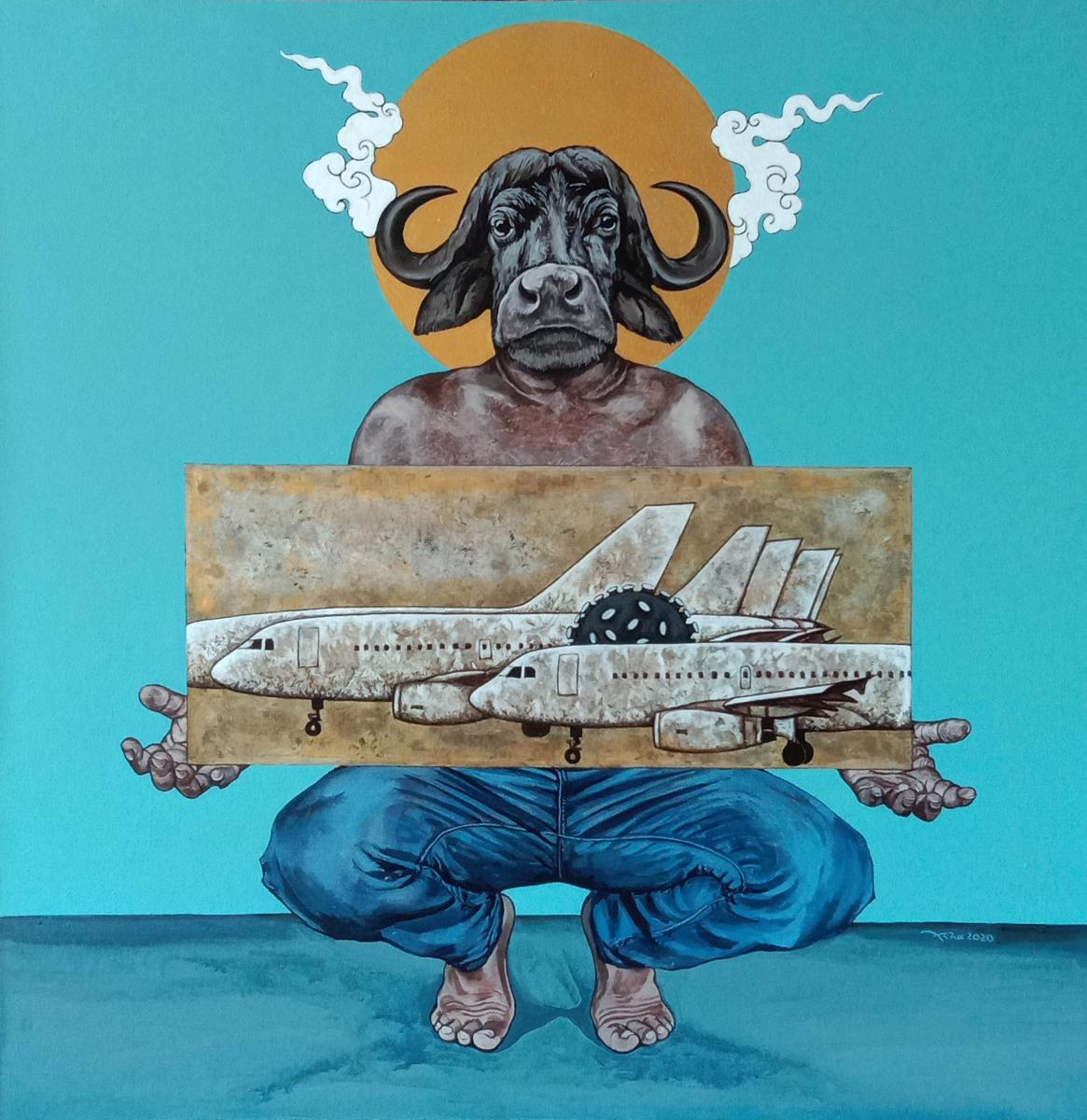Canvas Conversations
Erina Tamrakar and Asha Dangol are two exceptional artists from Nepal, known for their unique blend of heritage and modernity. Their lives are a testament to their passion and purpose, as they paint bright canvases with passion and purpose.

- Tell us about yourself, and the beginning of your family's journey.
Erina Tamrakar: As a child, I doodled on wood scraps in my parents' handicraft shop, igniting a passion for art. My journey evolved with poems and diverse artworks, shared with family and friends, shaping my artistic path.
Asha Dangol: With thirty years dedicated to art, I shifted from studying watercolor painting to exploring diverse forms at Lalit Kala. Guided by Prashant Shrestha, we founded the Kasthamandap group in 1994, navigating uncertainties post-college. Prashant's insight led us into contemporary arts, crystallizing our artistic objectives and fostering a bond rooted in shared creativity and goals.
- How do artistic expressions play a role in defining your family's identity and dynamics?
Erina: Back in the early days, selling art was tough; no one believed in us. It took two years of hard work and late nights before people started noticing. In 1994, I faced pressure to marry, but I stood my ground. I didn't want to be confined to household chores. Finally, in 2001, I joined Shrijana College of Fine Arts. Organizing an exhibition amazed my family, proving that being an artist was my path.
Asha: Talking about family and art, having a loving and huge family helped a lot since we have a kid and we must work late, which takes up space and uniqueness. Going globally also helped because we had our son and family understanding. But, individually, after graduation, my life began to suffer since I had to be away from my family for five years while working in the studio, and my parents had that support and trust. So, I must add that I am fortunate to have such strong family support.

- Can you share instances where engaging in artistic activities together has strengthened the bonds within your family?
Erina: During my struggling phase, I rejected a lot of proposals, and when I had to marry, I thought I would not marry, but if I did, I would marry an artist because it makes the overall thing much easier because we share each other's problems, and there is mutual understanding in every aspect of how things will go. We were already working together as solo artists, but being in a relationship strengthened it even more and added another dimension. And now that we are a power couple, everything seems more deep.
Asha: We have more space to communicate regarding work or family, which makes it easier for us to be honest. When we first started dating, we knew that money was tight, but now that we are more aware of the situation, we can motivate one another and try to give each other the space we need. The support of our families has also made the journey easier.
- Do your artistic creations reflect specific values or themes significant to your family, making it a distinctive and "smart" family?
Erina: Being an artist is an ongoing process that never leaves us because even when I observe things, I see art, the shade, colour, and shapes, and it's beautiful, and when I'm cooking, my mind is constantly playing the art, making every task engaging and beautiful, and being in a large family has pushed us to be what we are. Being a smart family requires inductivity and readiness as well because when a family supports you as ours did, we strived for the best because it was us at the same time. So, individuals and families need to go hand in hand, and I believe that's what makes our family a smart family because we're there for one another.
- Your paintings beautifully depict the interconnection between tradition and modernity. How do you navigate this balance in your artistic journey, and what inspired you to explore this theme?
Asha: Starting with a traditional college background, my journey took a significant turn during my master's in 2010. Opting to explore Newari art for my thesis, I discovered the perfect blend of my contemporary vision and traditional roots. Integrating Mithila and Newari art, I ventured into various materials and methods, striving to balance tradition's soul with fresh perspectives. It wasn't easy, but the challenge fuelled my quest for a harmonious coexistence of classic and modern elements in my art.
And after covid, I use my body figure with the head of an animal when asked why, as I use the head of a buffalo, goat, etc., so what I wanted to send the message is I don't like how the animals are being treated to convey the social message to protect them, and during covid, all humans were inside but all the animals were free, so I started with the title "we are also living beings".
.jpg)
- For Erina, your artistic journey has explored various themes, including motherhood and femininity. How has your sense of creativity evolved, especially when expressing the feminine experience in your art?
Erina: In the early days of my artistic journey, my friends and I explored various towns and villages to sketch. It was a revealing experience, highlighting the challenges women faced everywhere. Witnessing their struggles, from shouldering household responsibilities to enduring abusive relationships, left a profound impact. Despite the grim circumstances, I found resilience, grace, and strength in these women, qualities that captivated me amid the adversity.
To support women and empower them, I strive to accomplish things that you already know and have, as well as to celebrate and represent women in art. a call to action for all women in society to pursue their independence and happiness. In the third eye series by depicting the eye of Lord Shiva in my artwork, I aim to symbolize the inner strength and potential that women possess. This series serves as a reminder for women to embrace their power and strive for self-empowerment in all aspects of life.


